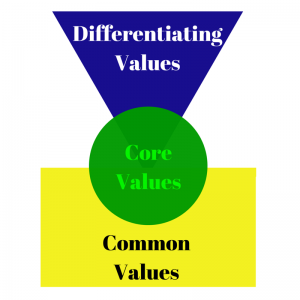A Better Way to Select Core Values
Many business leaders understand the importance of Core Values for their organization. In fact, they treat it with such importance that they can spend an inordinate amount of time and money selecting and defining their values.
 For example, last year, Penn State University hired an outside firm to conduct a Values & Culture survey. This was no small task, as they sent the 26-page survey to more than 130,000 people. The cost of just the data collection and analysis alone must have been enormous.
For example, last year, Penn State University hired an outside firm to conduct a Values & Culture survey. This was no small task, as they sent the 26-page survey to more than 130,000 people. The cost of just the data collection and analysis alone must have been enormous.
And the results?
Now Penn State president Eric Barron is soliciting feedback on their “draft” list of six values:
- Integrity: We act with integrity in accordance with the highest academic, professional, and ethical standards.
- Respect: We respect and honor the dignity of each person, embrace civil discourse, and foster a diverse and inclusive community.
- Responsibility: We act responsibly and hold ourselves accountable for our decisions, actions, and their consequences.
- Discovery: We seek and create new knowledge and understanding, and foster creativity and innovation, for the benefit of our communities, society, and the environment.
- Excellence:We strive for excellence in all our endeavors as individuals, an institution, and a leader in higher education.
- Community:We are Penn State, one University geographically dispersed, committed to our common values and mission, working together for the betterment of the University and the communities we serve and to which we belong.
I think I could have saved the university some time and money.
All six values can be found in the list of 17 Common Values. (Note: reading the definition of Discovery, this is really about Innovation).
In other words, Penn State’s extensive – and expensive – selection process provided a set of values that are the same as those shared by most other organizations.
Does this mean the process was a total waste of time and money? Not necessarily.
Penn State will indeed benefit greatly from having a clearly defined set of values. They just need fewer of them.
The Magic of Three
 Based on my research of values across Fortune 500 companies, the highest number of values I found was nineteen. That’s WAY too many! The smallest number was just one, which generally was a simple reference to Integrity in their Code of Business Conduct document.
Based on my research of values across Fortune 500 companies, the highest number of values I found was nineteen. That’s WAY too many! The smallest number was just one, which generally was a simple reference to Integrity in their Code of Business Conduct document.
The average number of values was 5 (actually, it was 5.3 but you can’t have .3 of a value). However, even 5 is too many values.
The best number is three.
In his book Managing by Values Ken Blanchard suggests three is the best number of values. Why? Because that’s all that we humans can remember. Any more than three (of anything) and most of us just can’t remember. (Note: Blanchard says, if you really must have four values, it’s ok. Most of our brains seem to be able to stretch that far – but no further).
Not surprisingly, many other consultants, researchers, and authors support Blanchard’s recommendation, including Patrick Lencioni in his book The Advantage. It just makes sense.
Now here’s the really important part…
If you have more than three values, neither management nor employees, associates, contractors, volunteers, teachers, suppliers, etc. will remember them. And if people can’t remember them, then they will have NO impact on decisions and behavior. So why bother having any values at all? And why spend all that time and money selecting and defining them?
There is a more cost-effective way.
A Better Way
 When leaders are selecting an organization’s Core Values, here’s what I recommend.
When leaders are selecting an organization’s Core Values, here’s what I recommend.
1. Select two values (max. 3) from the list of 17 Common Values. Only select values that you are prepared to associate with punishment. If you are not prepared to fire someone – including the CEO – over violating one of these values, then don’t select it. In other words, which two or three values, out of the list of 17 Common Values, really matter? Which ones will truly define the organization’s culture?
To help in choosing these values, here are a few tips that might help:
- Look for natural internal energy that already exists. For instance, if Fun is a core part of organizational behavior, then this might be a natural choice. A good example of this is Southwest Airlines and the entertaining antics of their flight crew. It’s not surprising that one of their values is a FUN-LUVing Attitude. If you don’t know how to have fun while working, then you shouldn’t work for Southwest.
- Peer-to-Peer Accountability. Living an organization’s values shouldn’t be the charge of management. It’s the responsibility of each employee. When an employee’s behavior contradicts a Core Value, other employees should feel empowered to stop that employee and say, “Hey, that might work elsewhere, but you can’t behave that way here!”
2. Select your top differentiating values. As outlined in my eBook Developing Your Differentiating Values, these are values that define a unique positioning and competitive advantage that will build your business and your brand. These are also the values you use as the basis to hire new talent. Ideally, you will identify the ONE thing that sets your organization apart from competitors. For example, Volvo is known for Safety; Disney is known for Magic; and 3M is known for Innovation.
When the leaders of an organization are ready to stand up and clearly state “this is who we are” and “this is what we want to be known for”, they are defining their Differentiating Values.
3. Define the Core. Now bring the two selected Common Values together with the top Differentiating Value, and define exactly what each of the values mean for the organization. Together these three values become your Core Values.
The process is actually quite simple. But it’s not necessarily easy.
The reason many organizations seek third-party help here is because it can be very difficult to decide which values NOT to select. But it can be done, and there are some great examples of companies that have carefully selected three Core Values that truly are making a difference, inside and out.
Does your organization need help selecting core values? I can help. Call me to discuss.








